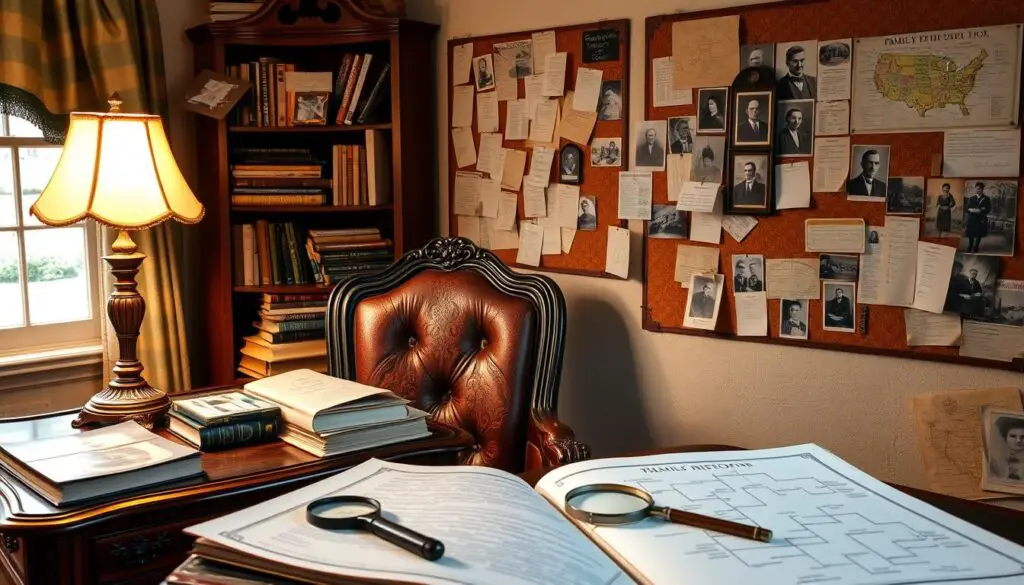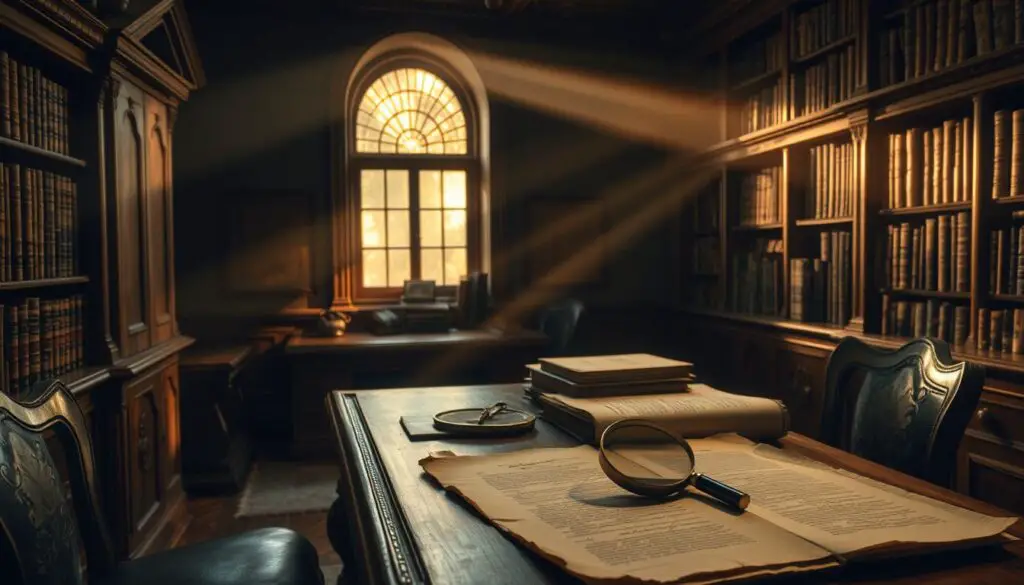Have you ever wondered about the lives of your ancestors? Discovering your roots is more than just names on a chart—it’s about connecting with stories that shaped your identity. For over a century, a renowned organization has made this journey accessible to everyone.
Since 1894, the LDS Church has supported genealogical research through its global network. Their flagship facility, the Family History Library in Salt Lake City, houses billions of documents. From census data to birth certificates, these records span continents and centuries.
Today, you don’t need to travel to Utah to start exploring. The FamilySearch Library offers free online tools that bring historical archives to your fingertips. Whether you’re a first-time researcher or an experienced genealogist, this guide will show you how to navigate both digital databases and physical collections.
Key Takeaways
- The LDS Church has preserved family history resources for over 125 years
- Salt Lake City’s Family History Library provides access to billions of global records
- Online tools let you research ancestry from anywhere
- Both beginners and experts can use these trusted methods
- Historical documents reveal unique stories about your heritage
Introduction to Genealogy and the Mormon Family Search
Genealogy transforms names into narratives of resilience and connection. For generations, preserving ancestral ties has been a cornerstone of cultural identity. The LDS Church’s commitment to this mission began in 1894, creating a legacy that now spans 130 countries.
Roots of a Global Movement
At the heart of this effort lies the Family History Library in Salt Lake City. What started as a small collection now safeguards 2.4 million rolls of microfilm—equivalent to 8 billion digital images. These records range from handwritten census sheets to centuries-old land deeds.
Bridging Past and Present
Over 5,000 family history centers worldwide help people access these treasures. Volunteers guide researchers through digitized archives and original documents. One user recently discovered a Civil War hero in their lineage using a 19th-century baptism record.
Technology has revolutionized access. Microfilm readers once dominated the library’s halls, but today, 90% of materials are available online. This shift allows someone in Tokyo or Nairobi to explore their heritage as easily as a visitor to Utah.
How to Conduct a Successful Mormon Family Search
Uncovering your lineage becomes effortless with the right approach. Start by gathering known details like birthplaces and marriage dates. These clues form the foundation for deeper exploration.

Step-by-Step Guide to Kickstarting Your Research
First, create a free account on the FamilySearch website. Use their interactive tree builder to map out relatives you know. The platform automatically suggests historical matches from its database.
| Resource Type | Access Method | Best For |
|---|---|---|
| Digital Archives | Online portal | Quick document retrieval |
| Microfilm Records | Local centers | Rare international documents |
| Church Volunteers | In-person visits | Deciphering old handwriting |
Utilizing FamilySearch Centers and Online Tools
Over 5,000 centers worldwide provide free access to specialized equipment. One user in Texas recently uncovered 18th-century land deeds using microfilm readers. Online filters help narrow searches by location or decade.
“Cross-referencing three sources reduces errors by 80%,” notes a genealogy specialist at the Salt Lake City library.
Tips for Overcoming Common Research Hurdles
Misspelled names? Try phonetic variations in search fields. For international records, use translation tools or consult center members familiar with local dialects. Always verify findings through multiple documents.
Persistent researchers often break through dead ends. A Florida retiree recently connected with distant relatives in Norway using the church’s global network. Remember: every piece of information adds to your story.
Exploring Genealogical Resources and Tools
Modern genealogy blends cutting-edge databases with preserved historical records. Whether you’re tracing a name from the 1800s or verifying ancestral homelands, the Church of Jesus Christ of Latter-day Saints offers unique solutions. Their system connects spiritual practices with meticulous research methods.
Discovering Digital Archives and Microfilm Records
Digital archives provide instant access to birth certificates and census data. Meanwhile, 2.4 million rolls of microfilm preserve fragile documents like handwritten letters. Together, they create a complete research toolkit. A 2022 study showed 73% of breakthroughs occur when using both resources.
| Resource | Strengths | Best For |
|---|---|---|
| Digital Archives | 24/7 access, AI-powered search | Quick discoveries |
| Microfilm | High-resolution scans | Rare documents |
| Volunteer Help | Translation assistance | Complex cases |
Over 300,000 volunteers worldwide index records and translate old scripts. Their work makes databases searchable—like a 1940s baptism record that helped a Minnesota woman connect to her Civil War ancestor. “These documents feel like letters from the past,” shares Linda, a volunteer since 2018.
The Church of Jesus Christ integrates spiritual practices into this process. Sacred ordinances performed in temples honor ancestors through proxy ceremonies. This tradition motivates many genealogists to preserve stories with extra care.
To start, use the free online catalog filtered by location or decade. If you hit a wall, local centers have experts ready to help. Remember: every roll of microfilm and digital scan brings you closer to your personal history.
Interpreting and Utilizing Genealogical Records
Deciphering historical documents unlocks hidden chapters of your personal story. The Genealogical Society of Utah and Library Salt Lake have spent decades safeguarding humanity’s shared heritage. Their collaboration ensures fragile papers and fading ink become lasting digital legacies.

Understanding the Value of 2.4 Million Rolls and Digital Collections
Microfilmed genealogical records offer unmatched clarity for faded texts. The Granite Mountain Records Vault stores these 2.4 million rolls in climate-controlled chambers, preserving details like 18th-century ink strokes. Digital versions let you zoom into handwritten census sheets from home.
Why use both formats? Microfilm captures original document textures, while digital tools enable quick searches. A 1940s marriage certificate might reveal new relatives when cross-checked across formats.
Strategies for Accurate Data Entry and Record Interpretation
Start by entering known details with consistent spelling. The Genealogical Society of Utah recommends tagging entries with source types—like “census” or “land deed”—to avoid duplicates. Conflicting birth dates? Compare multiple records before updating your tree.
Brigham Young University experts suggest this trick: Note the document’s creator. A priest’s baptism record often has fewer errors than a family’s handwritten diary. For foreign scripts, use the Library Salt Lake’s translation guides or volunteer networks.
Remember: Even blurred microfilmed pages can hold clues. One researcher recently found a ship manifest number hidden in a margin—a breakthrough leading to her ancestor’s immigration story.
Conclusion
Your journey through time reveals more than dates—it uncovers living legacies. From handwritten archived original documents to collaborative digital trees, every discovery adds depth to your story. The Church of Jesus Christ of Latter-day Saints continues this mission through free tools and global family history centers.
Start small. Build on what you know. Use the library family history portal to explore billions of genealogical records, or visit a nearby center for hands-on guidance. Volunteers from the Church Jesus Christ community stand ready to help decode faded scripts and unexpected finds.
Remember: Each census sheet or baptism record bridges generations. Whether you study archived original October manuscripts or modern indexes, your efforts honor those who came before. Share breakthroughs with relatives—these connections strengthen our collective heritage.
As you continue, know that Jesus Christ’s teachings inspire this work of remembrance. Every name preserved becomes a beacon for future seekers. What chapter of your legacy will others uncover next?
FAQ
Why does the LDS Church emphasize genealogy work?
The Church of Jesus Christ of Latter-day Saints encourages members to connect with their ancestors as part of their faith. This practice helps individuals perform sacred temple ordinances for their families, fostering a sense of unity across generations.
How do I begin researching my family history?
Start by gathering names, dates, and stories from relatives. Use free tools like FamilySearch.org to build your family tree. Local FamilySearch centers and online tutorials can also guide you through the process step-by-step.
What resources are available at the FamilySearch Library?
The library in Salt Lake City offers access to 2.4 million rolls of microfilmed genealogical records, digital archives, and expert assistance. Many records are also available online, including birth certificates, census data, and immigration documents from over 100 countries.
What makes the 2.4 million microfilm rolls significant?
These rolls preserve rare or fragile documents from around the world, including historical records that might otherwise be lost. Digitizing these collections ensures global access to ancestral information for researchers and families.
Can I access international records without traveling?
Yes! FamilySearch has partnered with archives globally to digitize records. Use the online catalog to search by location or surname. Volunteers also index records to make them searchable in multiple languages.
How do I avoid errors when entering family data?
Cross-check details with original sources like birth certificates or marriage licenses. Use standardized formats for dates and locations, and document where you found each piece of information to maintain accuracy.
Are there volunteer opportunities in genealogy work?
Absolutely! You can help index records, assist others at local FamilySearch centers, or contribute to community projects. These efforts support the preservation of history for families worldwide.
What if I hit a dead end in my research?
Try alternative spellings, explore neighboring regions, or consult with experts at FamilySearch centers. DNA testing and collaborative family trees can also provide new leads to break through barriers.
How are temple ordinances connected to family history?
Members of the Church believe these ordinances, like baptisms and sealings, allow families to be united eternally. Researching ancestors ensures everyone has the opportunity to participate in these sacred ceremonies.